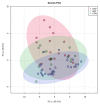Alterations in the Fecal Microbiome and Metabolome of Horses with Antimicrobial-Associated Diarrhea Compared to Antibiotic-Treated and Non-Treated Healthy Case Controls
- PMID: 34204371
- PMCID: PMC8235368
- DOI: 10.3390/ani11061807
Alterations in the Fecal Microbiome and Metabolome of Horses with Antimicrobial-Associated Diarrhea Compared to Antibiotic-Treated and Non-Treated Healthy Case Controls
Abstract
Diarrhea is an adverse effect of antimicrobial therapy in horses. This matched, case-controlled study compared the fecal microbiome and metabolome of horses on antibiotics that developed diarrhea (AAD, n = 17) to those that did not develop diarrhea (ABX, n = 15) and to a control population not exposed to antibiotics (CON, n = 31). Fecal samples were collected from horses that were matched for diet and antimicrobial agent (including dose, route, and duration of therapy). Illumina sequencing of 16S rRNA genes was performed, and QIIME 2.0 was used to generate alpha and beta diversity metrics. Untargeted metabolomics using GC-MS platforms was performed and analyzed using Metaboanalyst 5.0. Microbiome composition was significantly different in AAD compared to CON (ANOSIM, R = 0.568, p = 0.001) but not to ABX (ANOSIM, R = 0.121, p = 0.0012). AAD and ABX horses had significantly decreased richness and evenness compared to CON horses (p < 0.05). Horses on antimicrobials (AAD and ABX) had significant changes in 14 phyla compared to CON horses. Only Verrucomicrobia distinguished AAD from ABX and CON horses (q = 0.0005). Metabolite profiles of horses with AAD clustered separately from ABX and CON horses. Seven metabolites were found to be significantly different between groups (p < 0.05): L-tyrosine, kynurenic acid, xanthurenic acid, 5-hydroxyindole-3-acetic acid, docosahexaenoic acid ethyl ester, daidzein, and N-acetyltyramine. Metabolite profiles of horses on antimicrobials, especially those with AAD, are altered compared to CON horses.
Keywords: antimicrobial-associated diarrhea; colitis; metabolome; microbiota.
Conflict of interest statement
The authors declare no conflict of interest.
Figures











References
-
- McGorum B.C., Pirie R.S. Antimicrobial associated diarrhoea in the horse. Part 1: Overview, pathogenesis and risk factors. Equine Vet. Educ. 2009;21:610–616. doi: 10.2746/095777309X476871. - DOI
-
- Weese J., Baptiste K.E., Baverud V., Toutain P.L. Guidelines of antimicrobial use in horses. In: Guardabassi L., Jensen L.B., Kruse H., editors. Guide to Antimicrobial use in Animals. 1st ed. Blackwell Publishing Ltd.; Oxford, UK: 2006. pp. 161–182.
-
- Andersson G., Ekman L., Månsson I., Persson S., Rubarth S., Tufvesson G. Lethal complications following administration of oxytetracycline in the horse. Nord. Vet. Med. 1971;23:9–22. - PubMed
LinkOut - more resources
Full Text Sources
Miscellaneous

